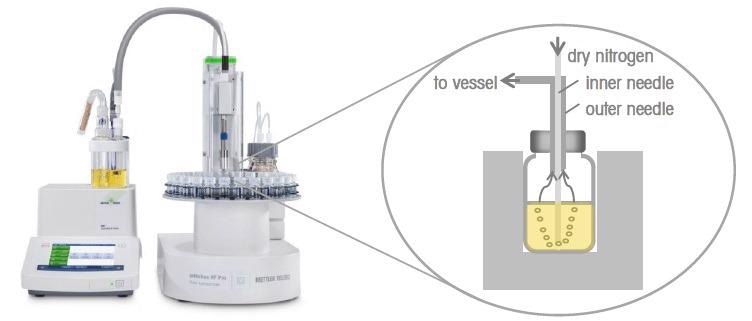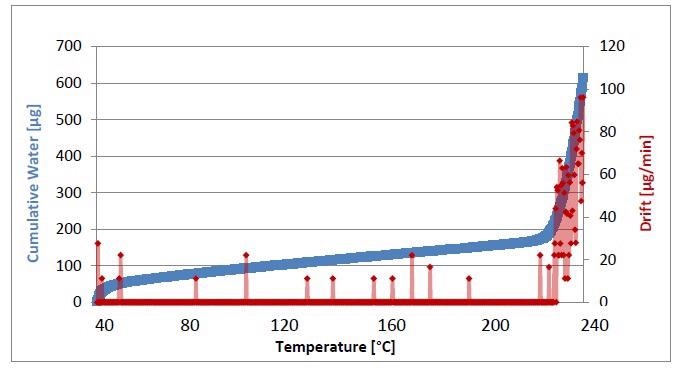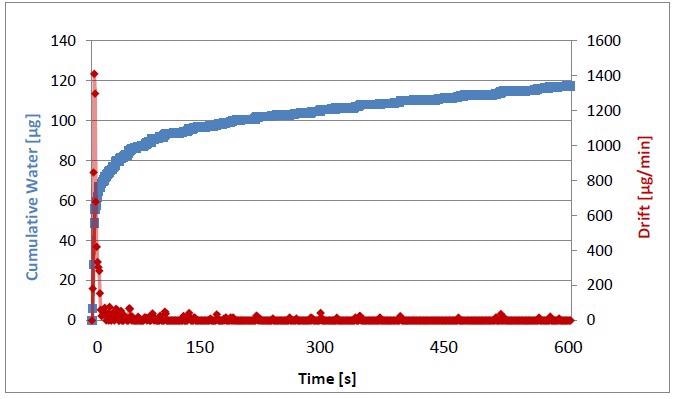Transformer oil, also referred to as insulating oil, is stable at high temperatures while offering superb electrical insulating properties.
Water impacts the insulation’s dielectric properties as well as insulating materials’ aging rate. As such, limits of 30 to 35 ppm of water in the transformer oil are generally referenced as acceptable standards.
Ensuring that water content in the transformer oil remains low is an important consideration when ensuring the safe operation, aging, and reliability of a transformer. In extreme circumstances, transformers may even fail as a result of excessive water in the insulation.
The use of Karl Fischer titration in conjunction with an oven sample changer is a widely recognized, established, and accurate technique for the determination of water content in transformer oils.
To investigate the effectiveness of this technique, a coulometric C30S Karl Fischer titrator was connected to an InMotion KF Pro and used to perform temperature scans of a number of transformer oil samples.
This was done in order to determine the samples’ ideal gas-phase extraction temperature before measuring their water content.
Air contains oxygen, and because oxygen has the potential to react with organic samples, it was important to utilize an inert gas (nitrogen) for the analysis of the transformer oil samples.

Image Credit: Mettler Toledo - Titration
Sample Preparation and Procedures
Scan Principle
A sample possessing an undetermined water gas-phase extraction temperature was heated. This was done with a constant heating rate, using a defined start and end temperature.
Any water released was monitored and recorded as a function of temperature, and it was possible to identify the ideal gas-phase extraction temperature through a qualitative interpretation of the curve.
Gas-Phase Extraction Principle
The purge gas used in this experiment was nitrogen from a gas cylinder. It is recommended that a two-stage pressure regulator be used, ensuring the final pressure is maintained in the range of 0.5 – 1 bar.
Nitrogen is passed via a gas stop valve, moving through a drying unit filled with silica gel and before passing through a further drying unit filled with molecular sieve. The nitrogen will facilitate the transfer of water into the titration cell.
Long Needle
The long needle developed for the 10 mL vial size should be utilized in the sample analysis. This long needle enables purging through the lubricant, resulting in the liberation of all water from it.
Blank Preparation
As well as water in the sample, the sample vial will also contain atmospheric humidity. This means that blank value determination should be performed by placing three empty 10 mL blank vials into positions 1 – 3 of the InMotion KF, then closing these with a screw cap.
Sample Preparation
Approximately 6.0 g of the transformer oil sample should be added into a 10 mL vial before this is closed with the screw cap. All filled vials should be placed into the corresponding positions of the InMotion KF rack.
Beginning Analysis
An empty vial should be placed into the rack’s drift position before commencing method M746. The method will perform a pre-titration, removing any excess water from the titration cell before moving into the Standby modus. Manual drift determinations should then be performed until the online drift value is <5 µg/min.
The ‘Start sample’ control can then be pressed. Alternatively, ‘Automatic’ mode can be selected in order to define the ‘Drift stability’ accordingly. The analysis will commence automatically once online drift is determined to be below the defined value.
The method will generally begin with the following sequence: Drift – Blank – Sample. In the majority of cases, drift is determined once prior to the sample loop. This drift value will then be utilized for all subsequent calculations.
Chemistry
Water, M = 18 g/mol.
ROH + SO2 + 3 RN + I2 + H2O = (RNH)•SO4 R + 2 (RNH)I
Solutions
- Chemicals: 100 mL HYDRANAL® Coulomat AG Oven.
- Standard: 1% oven water standard
- Sample: Transformer oils
Instruments and Accessories
- Compact line titrator C30S, titration cell without diaphragm (30252662)
- XPE205 Analytical balance (30087653)
- Titration Excellence T7 (30252675) or T9 (30252676), plus coulometric Karl-Fischer kit (30267113)
- InMotion KF Pro Oven Autosampler with 10 mL rack (30407502)
- Gas stop valve SV2 (30407442)
- Spatula
- LabX software
Results
In order to ensure optimal results, the gas-phase extraction temperature should be high enough to ensure that water release is fast and complete.
Should the measurement temperature be too high, organic molecules will be liberated by decomposition, causing these to react with titrants such as iodine. This reaction will ultimately result in an overestimation of water content.
A considerable increase in drift could be an indication of decomposition, for example, cumulative water content at high temperatures. Decomposition began between 150 to 210°C for the transformer oil samples investigated here.
Optimal gas-phase extraction temperature (oven temperature) was selected approximately 30°C below the recorded decomposition temperature.
The table below outlines water content determination of the NYTRO transformer oil sample. This was done at an oven temperature of 170°C and with a measurement time of 600 seconds. Waste was disposed of as organic solvent, according to relevant guidance.
Table 1. Source: Mettler Toledo - Titration
| |
R2: Water content
Blank: [µg], NYTRO Sample: [ppm] |
Blank 1
Blank 2
Blank 3
1
2
3
4
5 |
38.6
35.7
41.4
8.67
9.34
8.43
7.45
8.62 |
Mean
s
srel |
8.50 ppm
0.68 ppm
8.013% |
The table below displays oven temperature, measurement time and water content of three different transformer oil samples.
Table 2. Source: Mettler Toledo - Titration
| |
Oven T [°C] |
Time [s] |
Water content |
| Mean [ppm] |
s [ppm] |
srel [%] |
| NYTRO |
170 |
600 |
8.50 |
0.68 |
8.013 |
| T22 |
120 |
600 |
23.27 |
0.83 |
3.561 |
| T400 |
145 |
600 |
61.24 |
0.73 |
1.184 |
Discussion
Coulometric reagents possess only a limited water capacity, but the water capacity of the HYDRANAL® Coulomat AG Oven is 700 mg H2O per 100 mL reagent.
Due to the poor solubility of highly viscous petrochemical samples such as lubricating oils, etc., ASTM method D6304 has been revised. The standard method now includes the Karl Fischer (KF) oven method.
With the METTLER TOLEDO KF Oven autosampler, the innovative one-piece cap enables simple and fast sample preparation.
The oil sample directly can be directly weighed and fastened to the screw cap to protect samples from moisture and air contamination.
This increases lab efficiency; less time spent in preparing samples, so more time can be spent analyzing them.
References
- http://www.mt.com/global/en/home/products/Labo ratory_Analytics_Browse/Product_Family_Browse_ titrators_main/automated-titration-systems/KF- oven-autosampler.html
Measured Values

Scan NYTRO sample. Image Credit: Mettler Toledo - Titration

Water content determination NYTRO sample 1/5. Image Credit: Mettler Toledo - Titration
Table 3. NYTRO sample 1/5. Source: Mettler Toledo - Titration
| Consumption mC |
Meas. value mV |
H2O µg |
Drift µg/min |
Time s |
| 0.0 |
340.3 |
0.0 |
0 |
0 |
| 64.7 |
334.2 |
6.0 |
182.2 |
1 |
| 300.3 |
290.9 |
28.0 |
846.1 |
2 |
| 522.6 |
177.2 |
48.8 |
1411.2 |
3 |
| 597.2 |
118.1 |
55.8 |
1297.6 |
4 |
| 616.7 |
118.7 |
57.6 |
679.7 |
5 |
| 637.7 |
124.6 |
59.5 |
420.5 |
6 |
| 663.2 |
118.4 |
61.9 |
334.3 |
7 |
| 694.6 |
112.5 |
64.8 |
304.6 |
8 |
| 717.0 |
99.7 |
66.9 |
283.2 |
9 |
| 717.1 |
101.2 |
66.9 |
155.2 |
10 |
| 718.8 |
104.9 |
67.1 |
60.9 |
11 |
| 732.3 |
105.3 |
68.4 |
25.4 |
12 |
| 1255.8 |
96.5 |
117.2 |
0 |
594 |
| 1255.8 |
97.5 |
117.2 |
0 |
595 |
| 1255.8 |
103.1 |
117.2 |
0 |
596 |
| 1257.3 |
101.7 |
117.4 |
0 |
597 |
| 1257.4 |
101.7 |
117.4 |
0 |
598 |
| 1257.4 |
101.6 |
117.4 |
0 |
599 |
| 1257.6 |
97.1 |
117.4 |
0 |
600 |
| 1257.6 |
99.9 |
117.4 |
0 |
600 |

This information has been sourced, reviewed and adapted from materials provided by Mettler Toledo - Titration.
For more information on this source, please visit Mettler Toledo - Titration.